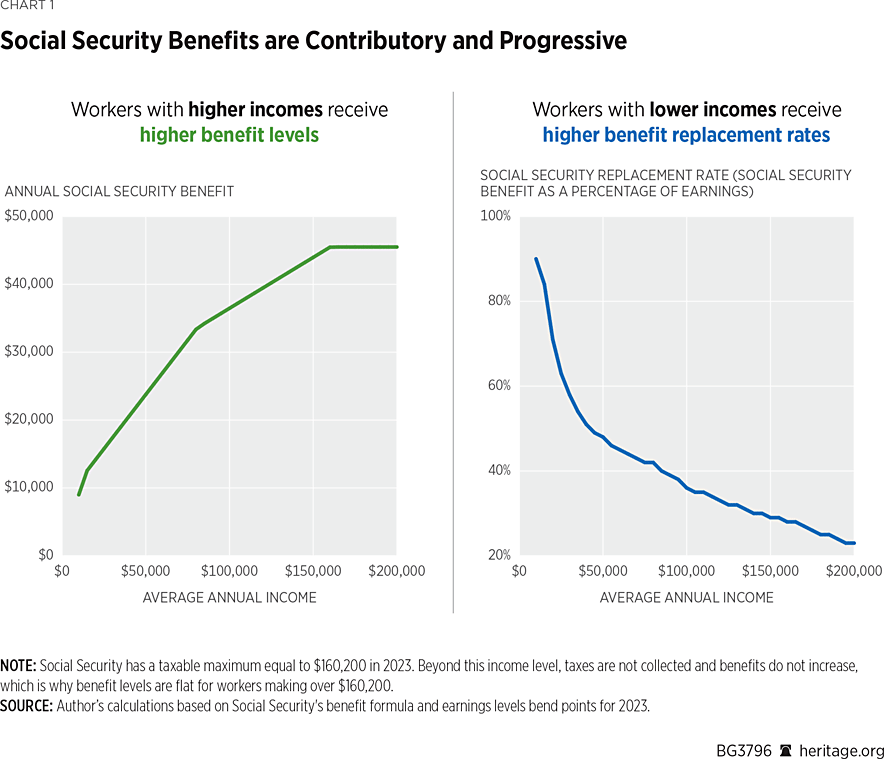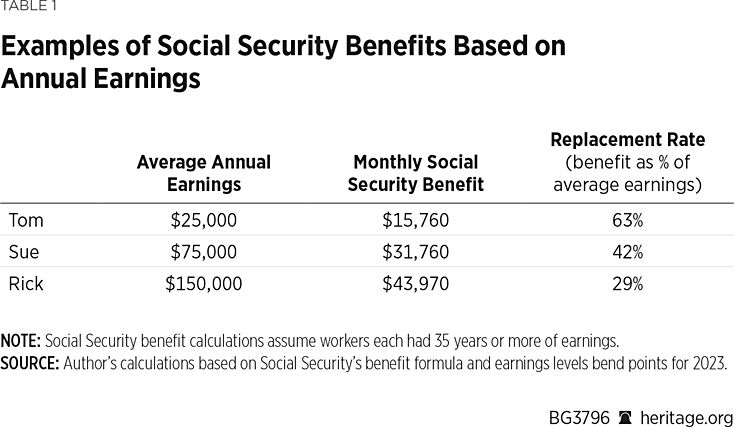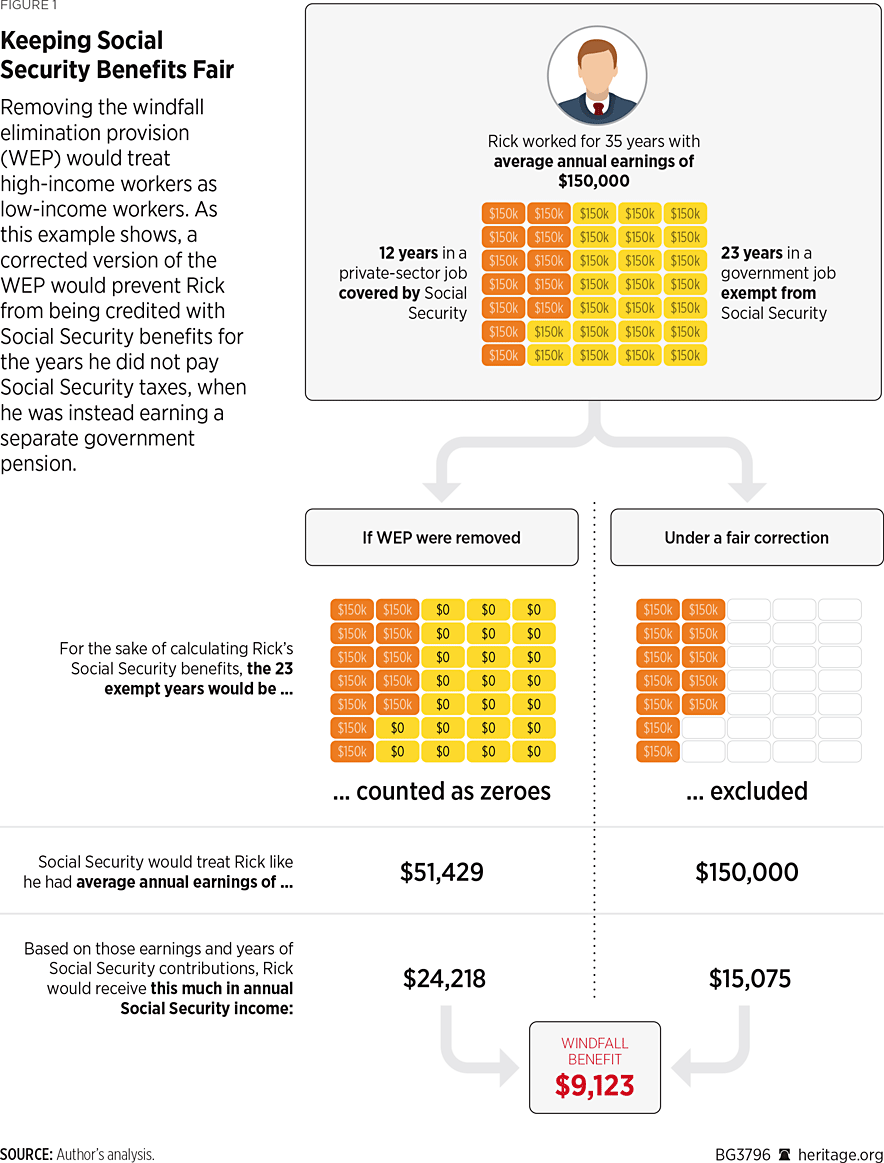Social Security is designed to be contributory and progressive, meaning that benefits are based on how much individuals pay into the system as well as on their earning levels, so that lower-income earners receive proportionally higher benefits (relative to their prior earnings). The exemption of some state and local government workers from Social Security led to unintended “windfall” benefits. Since Social Security only included a fraction of years that those individuals spent working (only those years in jobs that are not exempt from Social Security), they were treated as lower-income earners and received proportionally higher Social Security benefits despite having higher lifetime earnings.
Congress corrected those artificially high windfall benefits with the Windfall Elimination Provision (WEP) in 1983. Lacking sufficient data to design an accurate correction, the WEP results in some individuals receiving smaller (and some people larger) Social Security benefits than intended. Similarly, the Government Pension Offset (GPO) of 1977 provided an imperfect remedy to Social Security’s spousal benefit formula.
Congress has tried multiple times to address disparities caused by the WEP and GPO. A proposal by Representative Jodey Arrington (R–TX), the Equal Treatment of Public Servants Act of 2023, provides a long-term remedy to the WEP with modest short-term costs. Another proposal with multiple co-sponsors in the House and Senate, the Social Security Fairness Act of 2023, would eliminate the WEP and GPO entirely, reinstating unintended windfall benefits at a cost of $183 billion and causing Social Security to become insolvent more than a year earlier, in 2032 instead of in 2033.
Policymakers should build on the Equal Treatment for Public Servants Act by expediting the shift to accurate benefit calculations and should also implement a similar proportional remedy for the GPO. This would preserve Social Security’s progressive and contributory intent while also improving the program’s shortfalls. To help to gain bipartisan support, policymakers could consider incorporating a Social Security credit for years spent out of the formal workforce while raising children.
How Are Social Security Benefits Calculated?
As mentioned, Social Security benefits are contributory and progressive, taking into account taxes paid into the system as well as earnings levels. Designed at a time when few married women participated in the formal labor force, Social Security includes a spousal benefit so that individuals who do work long enough to receive a benefit of their own can receive a benefit equal to half of their spouse’s benefit.
When individuals file for Social Security’s benefits upon reaching their normal retirement age of 67 (for those born in 1960 or later),REF or as early as age 62 for individuals claiming early retirement benefits,REF the Social Security Administration uses workers’ earnings records to calculate their monthly benefits. Benefits are based on a worker’s average indexed monthly earnings (AIME), over their highest 35 years (420 months) of earnings. If an individual worked for 42 years, his lowest seven years of earnings are not included, and someone who worked only 25 years will have 10 zero-earning years included in his AIME.
A worker’s AIME is then broken down based on income-level “bend points” and multiplied by progressive “replacement rate” percentages. The first $1,115 of monthly earnings is multiplied by 90 percent; the next $1,116 to $6,721 is multiplied by 32 percent; and amounts between $6,722 and $13,350REF are multiplied by 15 percent. This method mechanically works in a similar fashion to the federal government’s progressive income tax rates that increase as incomes rise, but because Social Security is a transfer payment instead of a tax, the rates decline as incomes rise.

To be eligible for a Social Security benefit based on one’s own earnings, an individual must have worked and contributed to Social Security for at least 10 years (40 quarters). Individuals who did not work at least 40 quarters are eligible to receive a spousal benefit equal to one-half of their spouse’s benefit so long as they were married for at least 10 years.
Table 1 shows the Social Security benefits of workers with different average income levels over the course of their careers.

The examples in Table 1 demonstrate Social Security’s contributory and progressive nature. “Tom” had the lowest earnings, receives the lowest benefit amount, and has the highest benefit replacement rate. “Rick” had the highest earnings and receives the highest benefit amount but has the lowest replacement rate.
Impetus for the Windfall Elimination Provision and Government Pension Offset
While nearly all workers and employers must pay into Social Security, some jobs—namely state and local government jobs—were, and may still be, exempt. Because Social Security benefits are based on average earnings over 35 years, and years spent in exempt or non-covered employment are counted as zero earnings, Social Security’s original benefit formula resulted in windfall benefits for many workers. Specifically, many who worked in both Social Security–covered and non-covered employment received higher Social Security replacement rates than individuals with the same earnings who worked exclusively in Social Security–covered employment.
Example: Windfall Elimination Provision. Prior to the WEP, those who worked in jobs exempt from Social Security taxes often received larger Social Security benefits than the program intended. Using the same examples of Tom, Sue, and Rick above, suppose that Rick spent only 12 years of his career in Social Security–covered earnings and the other 23 in a job that was exempt from Social Security taxes and provided a separate pension, his 23 years would be counted as zeros even though he was earning $150,000 each year. Thus, his average earnings according to Social Security’s formula would be only $51,429 instead of $150,000. Prior to the WEP, Rick would have received a $24,218 annual Social Security benefit, which is in line with a 47 percent replacement rate for someone whose entire earnings were subject to Social Security taxes. Consequently, prior to the WEP, Rick would have received a proportionally higher Social Security benefit than Sue (whose benefit equals a 42 percent replacement rate) even though his earnings were twice as high as Sue’s, and even though he earned a separate, non–Social Security government pension.
What makes this calculation counter to Social Security’s intent is that it treats Rick like a lower-income earner when, in fact, he had high earnings that were not taxed by Social Security and which contributed to his separate, non–Social Security government pension. Supposing that Rick’s other government pension provided the same benefits as Social Security, he would receive a government pension of $28,895 plus a Social Security pension of $24,218.REF In total, Rick’s Social Security and government pensions would equal $53,113, which is $9,143 more than the $43,970 he would have received if his entire career had been in Social Security–covered employment.
The logical correction is to exclude Rick’s years outside the Social Security system, rather than counting them as zero. Thus, Rick’s benefit would be calculated based on his $150,000 of average earnings in his years of Social Security employment, and his benefit would then be multiplied by the percentage of his total work years that were spent in Social Security–covered jobs (12 years divided by 35 years), which equals 34 percent. Thus, Rick’s Social Security benefit would be $15,075, which is directly proportional to the number of years he paid into Social Security, and results in the same replacement rate as Social Security intends for a worker with Rick’s earnings level.

Lacking sufficient earnings data to legislate an accurate remedy, policymakers implemented an ad hoc formula that reduces Social Security benefits based on a worker’s number of years with substantial earnings in Social Security–covered employment.REF The more years a worker spent in Social Security–covered employment, the smaller the reduction in his Social Security benefit. The WEP is capped and cannot take away more than half of a worker’s Social Security benefit. Based on the current WEP formula, Rick’s Social Security benefit would be reduced by $6,690, taking it from $24,218 to $17,528.REF In Rick’s case, the current WEP formula still provides him with a windfall benefit compared to what he would have received had all his earnings been in Social Security–covered employment, but it is a smaller windfall than what Social Security provided without the WEP. Under the current WEP, there are also workers who pay a WEP penalty because the ad hoc formula results in them receiving less than they would have received had all their earnings been in Social Security–covered employment.
Example: Government Pension Offset. Prior to the GPO, those who worked in jobs that were exempt from Social Security taxes and provided separate government pensions could also receive Social Security spousal benefits equal to what individuals with little or no work history received. The spousal benefit allows individuals to receive the greater of their own earned benefit, or 50 percentREF of their spouse’s benefit, and it was designed to support spouses—namely women—who generally stayed at home to care for children and a household. Individuals who worked in jobs exempt from Social Security often looked like stay-at-home-spouses or very low-income earners for purposes of Social Security benefit eligibility. In reality, they worked and earned government pensions of their own and did not have to pay into the Social Security system.
For example, if Sue and Rick were married and both worked in Social Security–covered jobs, Sue’s individual benefit of $31,760 would be greater than the spousal benefit of $21,985 (half of Rick’s $43,970), so she would not receive a spousal benefit. If Sue had the exact same earnings and the exact same pension of $31,760 in a job exempt from Social Security, then, prior to the GPO, she would have received both her $31,760 pension and a $22,000 Social Security spousal benefit.
The logical correction to this discrepancy is to calculate an imputed Social Security benefit for Sue, assuming that her Social Security–exempt earnings had instead been in Social Security–covered employment. That would make Sue’s imputed Social Security benefit equal to $31,760, and because this amount is greater than the $21,485 spousal benefit that Sue could receive on behalf of Rick, she would not be eligible for a spousal benefit.
Since sufficient earnings data did not exist to provide an accurate remedy, policymakers provided a simple change that aimed to get close to the correct amount, but nevertheless resulted in some people receiving more or less than an accurate correction would have provided. In the case of Sue and Rick, Sue’s spousal benefit is reduced by two-thirds of the amount of her government pension. Two-thirds of $31,760 equals $21,173, and her spousal benefit of $21,485 minus $21,173 equals $312. So, Sue is left with a small spousal benefit, which is larger than the $0 she would have received if her earnings had been in Social Security–covered employment but is much less than the $22,000 windfall she would have received absent the GPO.
Time for a Fair Correction
At the time that Congress sought to correct these windfall benefits through the GPO in 1977 and the WEP in 1983, sufficient earnings records did not exist to allow appropriate corrections as described above. Consequently, the GPO and WEP imposed ad hoc adjustments that aimed to preserve Social Security’s intent but resulted in some people having their Social Security benefits reduced by more or less than an arguably fair amount.
Today, sufficient earnings records exist to provide correct, proportional corrections that would preserve Social Security’s intent while improving the program’s finances.REF The crux of an appropriate remedy is to presume that a worker’s entire earnings had been in Social Security–covered employment, to calculate the benefit based on the worker’s entire career, and then to credit the worker with a proportional benefit based on years of Social Security earnings as a percentage of total years of earnings. These corrections could be implemented through a near-term transition period, allowing those close to retirement to receive the greater of the current and corrected formulas, and shifting others fully to the correct formula over a period of 20 years or 30 years.
To increase the political viability of an accurate remedy, policymakers could consider pairing a WEP and GPO correction with a modernization of the spousal benefit to more accurately reflect women’s increased participation in the workforce since Social Security’s inception. That could include sharing of benefit credits between couplesREF and the addition of a caregiver credit provided to one parent or legal guardian for years spent outside of the formal labor force while raising children.
Such a credit could provide a modernized version of the spousal benefit by acknowledging that most women participate in the formal labor force for some or most of their adult lives. A per-child credit would support parents, and it would also reduce Social Security’s implicit tax rate for many parents who spend time both in and out of the formal workforce.REF
Equal Treatment of Public Servants Act: Provides Long-Term Remedy for WEP at No Net Cost
The proposed Equal Treatment of Public Servants Act of 2023 (H.R. 5342) ultimately achieves a fair and accurate correction to the WEP.REF The proposal includes a full remedy for individuals who retire in 2068 or later (effectively, people born in 2000 or later), but allows everyone retiring in 2067 or earlier to receive the larger amount of either the current, flawed formula or the newly corrected formula. Social Security’s Chief Actuary estimated that an earlier version of the Equal Treatment of Public Servants Act would cost $26.3 billion over the first 10 years and be revenue neutral over the long term.REF
Congress could improve the Equal Treatment of Public Servants Act by gradually phasing in the remedy over the next 30 years instead of allowing retirees to receive the best of both calculations for 45 years. Moreover, adding a similar remedy to the GPO would provide a comprehensive solution to fairly calculate benefits while strengthening Social Security’s solvency and minimizing future benefit reductions already incorporated into current law.
Social Security Fairness Act: Reverts to Original Flawed Formulas at Cost of $183 Billion and Hastens Social Security’s Insolvency
Unlike the Equal Treatment of Public Servants Act, which corrects the current problem of an imprecise benefit offset formula for the WEP, lawmakers in the House and Senate have proposed a bill, the Social Security Fairness Act of 2023 (H.R. 82 and S. 597), that would eliminate the WEP and GPO altogether.REF By returning to the flawed formulas of more than 40 years ago that provided large windfall benefits, the Congressional Budget Office estimated that eliminating the WEP and GPO would cost $183 billion over the next 10 years and cause Social Security to become insolvent more than a year earlier, in 2032.REF When Social Security becomes insolvent, all retirees will be subject to 23 percent benefit cuts, with an average loss of more than $5,000 per year for a typical retiree.
Conclusion
When Congress attempted to eliminate windfall benefits that were accruing to individuals who had been exempt from Social Security taxes for part of their career by enacting the WEP and GPO, sufficient data did not exist to provide an accurate correction, and the ad hoc correction resulted in some individuals continuing to receive windfall benefits while others received penalties as a result of their earnings outside the Social Security system. Sufficient data now exist to allow an accurate correction. Representative Arrington’s Equal Treatment for Public Servants Act provides a long-term correction to the WEP, with no long-run cost. Hastening the implementation of that proposal and adding a correction to the GPO would provide a comprehensive solution.
The Social Security Fairness Act, on the other hand, would revert to the deeply flawed benefit system at a cost of $183 billion while hastening Social Security’s looming insolvency and across-the-board benefit cuts. Policymakers should preserve Social Security’s original intent of providing progressive and contributory benefits by taking workers’ full earnings histories into account when calculating benefits. An accurate remedy would reduce Social Security’s long-term costs and improve its long-term finances.
Rachel Greszler is Senior Research Fellow for Budget and Entitlements in the Grover M. Hermann Center for the Federal Budget at The Heritage Foundation.




